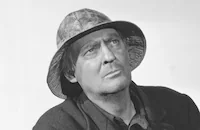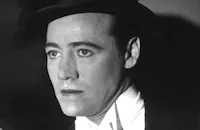Night Flight

Brief Synopsis
Cast & Crew
Clarence Brown
John Barrymore
Helen Hayes
Clark Gable
Lionel Barrymore
Robert Montgomery
Film Details
Technical Specs

Synopsis
As a worried mother comforts her desperately ill son in Rio de Janeiro, the child's physician, Dr. Decosta, assures her that, thanks to the new night flying schedule of the Trans-Andean European Air Mail, which is being inaugurated that evening, they will receive a life-saving serum the next day. In Santiago, Chile, pilot Auguste Pellerin leaves for Buenos Aires, the airline's headquarters, with the medicine. Rough weather makes his flight a harrowing one, and the shaken Pellerin is grateful to land safely, even though the airline's stern director, A. Riviére, fines him for being late. Over the objections of Daudet, the airline's president, and other board members, Riviére determines to make the night flight program successful and downplays the dangers of South America's unpredictable weather. Riviére is a harsh taskmaster who deeply respects his pilots even while driving them ever harder, and his no-nonsense tactics intimidate his more easy-going inspector, Robineau. Meanwhile, pilot Jules Fabian and his wireless operator, H. Guimet, have left Punta Arenas in the southern tip of Chile and are alarmed by the appearance of a sudden rainstorm. Fabian's wife Simone is waiting at home for him and has prepared a special dinner to celebrate his first night flight. Although Guimet wants to land in nearby Bahia Blanca, Argentina, Fabian decides to persevere, for he knows that they will be fined if they are late. They radio to headquarters that they are flying blind, but their transmission is cut off. As Simone grows more concerned, Fabian is driven farther off-course by the worsening storm. After Robineau returns to the office following a dinner with Pellerin, Riviére reprimands him for socializing with the pilot, and forces him to punish Pellerin for a fabricated offense as a lesson. Riviére also calls upon a Brazilian pilot to take the mail to Rio, and the pilot's wife pleads with him not to go. Simone, who realizes that her husband has been dangerously delayed, arrives at headquarters after Riviére refuses to give her any information over the telephone. While Simone waits anxiously for news, Fabian and Guimet, who believe that they have passed the worst of the storm, are forced to jump from their plane when it runs out of fuel. The storm has driven them over the ocean, however, and both men jump to their death in the churning water. At the airport, Simone realizes that Fabian is dead and hysterically accuses Riviére of treating the pilots like machines. Riviére explains that the night mail must go through regardless and, after overcoming more resistance from Daudet, sends the Brazilian pilot to Rio. Despite his wife's worries, the pilot makes his run safely and on time, and even though he believes that the only value of night mail is that someone in Paris can get a postcard on Tuesday instead of Thursday, its real value is proven when the serum reaches Dr. Decosta and the ill child is saved.

Director

Clarence Brown
Cast

John Barrymore

Helen Hayes

Clark Gable

Lionel Barrymore

Robert Montgomery

Myrna Loy

William Gargan

C. Henry Gordon

Leslie Fenton
Harry Beresford

Frank Conroy

Dorothy Burgess

Irving Pichel
Helen Jerome Eddy
Buster Phelps

Ralf Harolde
Marcia Ralston
Crew
Charles Dorian
Elmer Dyer
Hobe Erwin
Eddie Fitzgerald
Oliver H. P. Garrett
Hal C. Kern
Oliver T. Marsh
Charles Marshall
Kyme Meade
Oscar Radin
David O. Selznick
Douglas Shearer
Robert Shirley
Herbert Stothart
Alexander Toluboff

Videos
Movie Clip



Film Details
Technical Specs

Articles
Night Flight
Saint-Exupery's 1931 best-seller drew its inspiration from the author's experiences as a pilot and director during the formative years of the Argentinean commercial air service Aeroposta Argentina, and screenwriter Oliver H.P. Garrett had to expand the novel's spare, intimate narrative into an ensemble piece. Starting with a Rio hospital's plea to doctors in Santiago, Chile for delivery of much-needed serum, the scenario follows day one of a South American carrier's first venture into overnight delivery, where its pilots must deal with the heretofore unknown perils of flying after dark. Cracking the whip over the entire enterprise is the driven operations director Riviere (John Barrymore), determined to see all connections made seamlessly and demonstrating zero tolerance for any employee not holding up their end. A frequent target of his wrath is the middleman inspector Robineau (Lionel Barrymore), particularly over his penchant for getting chummy with the pilots he's supposed to reprimand.
The precious medicine makes the harrowing jump across the Andes and arrives at the company's Buenos Aires hub without incident, thanks to the aerial skill of the garrulous playboy Auguste Pellerin (Montgomery). More perilous, however, is the northbound east coastal run north from Punta Arenas, piloted by Jules Fabien (Gable), due to the unanticipated materialization of a vicious thunderstorm. With radio contact lost, and fully aware of how little fuel Fabien has left, Riviere tries to stonewall the airman's devoted wife Simone (Hayes) regarding the grim truth of his predicament.
For all the star power vested in casting Night Flight, the marquee names, on balance, have precious little interaction amongst themselves. Gable, in particular, is never seen outside the cockpit, and his exposition to co-pilot Leslie Fenton is primarily in the form of passed notes. Loy's participation comes primarily in the third act, as the worried wife of William Gargan, the flyer on the Buenos Aires-to-Rio leg. "We did that picture in bits and pieces, episodes with different characters who never met," Loy wrote in her 1987 autobiography Being and Becoming. "I didn't see Jack or Helen or anybody but Bill Gargan, whom I'd adored since The Animal Kingdom [1932]. We had a very nice scene as he goes off on a fatal flight, which everybody seemed to do in that picture." (Night Flight's long sequestration might have helped hinder Ms. Loy's recall; the movie's denouement clearly shows Gargan completing his mission safely.)
In her 1990 memoir My Life in Three Acts, Hayes recounted her trepidation over lensing her key scene opposite John Barrymore, when Madame Fabian confronts Riviere over the truth about her husband's fate. "John had a tempestuous personality and a well-deserved reputation for throwing people off, for unnerving even the most experienced actors...Determined to give him no cause to blow up at me if I could help it, I memorized my lines until I could say them in my sleep." The hard-living Barrymore was heavily reliant on cue cards by that point in his career, and while the crew had them ready, the take proceeded flawlessly. "Our director, Clarence Brown, was astonished," Hayes recollected. "'I can't believe it, John,' he said. 'You didn't need the idiot cards. What happened?' 'I was working with a real actress,' said John. 'I didn't want to make a goddamn fool of myself.' That, coming from John Barrymore, America's great actor, remains my favorite notice."
In crafting his performance as the conflicted inspector, Lionel Barrymore was disconcertingly relentless in embellishing the character's complaints of eczema by unrelievedly scratching at himself. The elder Barrymore's penchant for scene thievery by such maneuvers was the stuff of legend, and he probably took some particular delight in victimizing his matinee idol kid brother. The Jay Robert Nash/Stanley Ralph Ross/Robert B. Connelly Motion Picture Guide recounted how Brown bet John ten bucks that Lionel couldn't upstage him in the sequence where Riviere dressed down the hapless Robineau. "When the scene was shot, Lionel stood mute, his face twitching, his eyes rolling, but the script had silenced even his notorious whine. He turned to go, but when he reached the door...he reached his hand behind him and scratched his bottom. Beamed John to Brown: 'Now there, sir, is a brother to be proud of. Pay me the ten dollars!'"
Producer: Clarence Brown
Director: Clarence Brown
Screenplay: Oliver H.P. Garrett (screenplay); Antoine de Saint-Exupéry (novel)
Cinematography: Oliver T. Marsh
Art Direction: Alexander Toluboff; Cedric Gibbons (uncredited)
Music: Herbert Stothart
Film Editing: Hal C. Kern
Cast: John Barrymore (Riviere), Helen Hayes (Madame Fabian), Clark Gable (Jules), Lionel Barrymore (Robineau), Robert Montgomery (Auguste Pellerin), Myrna Loy (Wife of Brazilian pilot), William Gargan (Brazilian pilot), C. Henry Gordon (Daudet), Leslie Fenton (Jules' Radio Operator/Co-Pilot), Harry Beresford (Roblet).
BW-84m.
by Jay S. Steinberg

Night Flight
Quotes
Trivia
Notes
The working title of this film was Dark to Dawn. According to New York Times review, author Saint-Exupéry based his book on his experiences as an airmail pilot in France. The onscreen credits included the following statement: "The entire action of the play is between noon and midnight." New York Times review made the following comments on the film: "Many of the scenes are revealed by expert and imaginative methods. One May be gazing at one of the lights and it gradually opens up and reveals a glimpse of a flying field, a wife at home, or a pilot speeding through a fog-ridden cavern in a mountainous region." A Film Daily pre-production news item announced that Franchot Tone, Frank Morgan and Ben Lyon were to co-star in the film with Helen Hayes. According to International Photographer, "cloud shots" for the production were filmed in Denver, CO. M-G-M publicity material touted the fact that day-for-night shooting, using infrared film, was done for the first time in a commercial production on Night Flight.
In her autobiography, Myrna Loy describes the production: "We did that picture in bits and pieces, episodes with different characters who never met. I didn't see Jack [Barrymore] or Helen [Hayes] or anybody but Bill Gargan...." Although Night Flight was the first picture to co-star Loy and Clark Gable, Loy claims that she actually "didn't work" with Gable on the film. Modern sources add the following information about the production: Executive producer Selznick borrowed writer Oliver H. P. Garrett from Paramount and assigned him to write a script to rival Howard Hughes's successful 1931 film Hell's Angels. Working closely with Selznick, Garrett wrote a first draft, but Selznick felt that too much of the action of that script took place on the ground and hired John Monk Saunders to build up the flying sequences. When director Clarence Brown expressed dissatisfaction with Saunder's draft, Selznick brought in Wells Root, another seasoned action writer, to tighten it up. When the picture had its first preview, it ran over two hours, but was cut significantly before its general release. Despite its all-star cast, Night Flight, which cost $500,000 to make, was Gable's lowest grossing film since Polly of the Circus.














